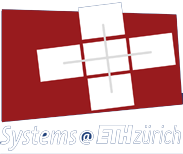Publication
Systems Group Master's Thesis, no. 6; Department of Computer Science, April 2011
Supervised by: Prof. Gustavo Alonso
Supervised by: Prof. Gustavo Alonso
This thesis presents a mechanical pattern-based transformation method for introducing an asynchronous communication mode in a legacy PL/I application running on the IMS platform. The method is presented as part of a more generally applicable framework of governing high-level solution concepts. Together, the solutions form a cost-flexible spectrum of holistic approaches ranging from a Synchronous Callout to a full asynchronous Request/Callback-based mode.
The provided reengineering patterns consist of well-defined mechanical steps; hence the resulting cost is highly predictable. As a further benefit, both the patterns and solutions are mutually independent, thereby making the framework modular and in turn facilitating enhancement and replacement on the level of individual components.
Work on this project was initiated as a result of newly arising circumstances in the IT infrastructure of Credit Suisse. For the first time, the mainframe is expected to serve as a client of cross-platform communication and as previous research has shown, synchronous communication may in many cases prove insufficient. The approach demonstrated in this work was designed to mitigate the corresponding deficiencies. It is expected to serve as a foundation for a complete, inexpensive reengineering solution with well-defined risks that will considerably ease the upcoming large-scale migration of legacy applications away from the mainframe.
@mastersthesis{abc,
abstract = {This thesis presents a mechanical pattern-based transformation method for introducing an asynchronous communication mode in a legacy PL/I application running on the IMS platform. The method is presented as part of a more generally applicable framework of governing high-level solution concepts. Together, the solutions form a cost-flexible spectrum of holistic approaches ranging from a Synchronous Callout to a full asynchronous Request/Callback-based mode.
The provided reengineering patterns consist of well-defined mechanical steps; hence the resulting cost is highly predictable. As a further benefit, both the patterns and solutions are mutually independent, thereby making the framework modular and in turn facilitating enhancement and replacement on the level of individual components.
Work on this project was initiated as a result of newly arising circumstances in the IT infrastructure of Credit Suisse. For the first time, the mainframe is expected to serve as a client of cross-platform communication and as previous research has shown, synchronous communication may in many cases prove insufficient. The approach demonstrated in this work was designed to mitigate the corresponding deficiencies. It is expected to serve as a foundation for a complete, inexpensive reengineering solution with well-defined risks that will considerably ease the upcoming large-scale migration of legacy applications away from the mainframe.},
author = {Lucia Ambrosova},
school = {6},
title = {A cost-flexible approach to transforming a legacy PL/I application to perform an asynchronous remote service call},
year = {2011}
}

